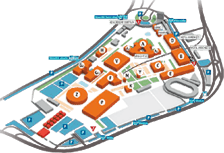IDET
24.-26.5. 2023
International Defence and Security Technologies Fair

An all-rounder instead of a battle Mi-24. The Army wants new helicopters
The Air Force expects an acquisition of new helicopters in the coming years. It will say goodbye to the a heavy Mi-24 battle aircraft, obtained with others as an unblocking of the Russian debt. Even the Polish Sokol rescue helicopters may be laid off. Defence Minister Martin Stropnický must find the billions of Crowns for the new multipurpose helicopters in the already tight budget.
Soldiers and ministry officials still refuse to even outline what type of specific machinery could the Czech Republic be interested in, which is usual in such cases - the tender has not yet been announced and by mentioning a few types, Czech representatives could become the subject of criticism for favouring someone.
This is a sensitive issue especially for large defence contracts, mainly due to suspicion of corruption and unfairness in the previous costly acquisitions. A the helicopters would be larger acquisitions - if the purchase is approved, they will cost the ministry billions of Crowns.
Some guidance on what types of machines the CR may be interested in can be found in the concept of transport and helicopter aviation, approved last November.
"Since 2013, the phasing out of operations of the Mi-24/35 helicopters is planned. The whole phasing out of their entire operation is associated with the planned replacement for multipurpose helicopters so that it would be possible to secure a wide range of tasks performed by this type of helicopters," reads the text. According to the Army News website the Mi-24 helicopters lifetime expires in the period 2016-2018.
From the words of General Staff spokeswoman Jana Růžičková it seems the army is really interested in a helicopter-all-rounder. "This includes support of ground forces, air reconnaissance, command and control, fire support, destroying ground targets, supporting special operations, search and rescue, and MEDEVAC," she listed the required capabilities for iDNES.cz.
Twelve helicopters at least
According to the document in question, there should be "at least a dozen" helicopters. They should be equally divided into two squadrons which will be in addition to multi-task aircraft also made up of modernized versions of the Russian Mi-17, designated Mi-171š. There should be eight of the in every squadron. Both squadrons will be located at the bases of Sedlec, Vícenice by Náměšť nad Oslavou, which has been modernized with over four billion Crowns in recent years. One squadron should have priority to support special forces.
If the CR buys more helicopters, six more machines could replace the rescue helicopters W-3A Sokol, operating under the Air Transportation Base in Kbely, and maybe even the helicopters Mi-8. However, it will depend on whether the Department of Defence selects the type able to perform the tasks of both the Sokol helicopters and the Mi-8.
The range of aircraft which would correspond to the "light or medium-sized multipurpose aircraft", is too broad without further specification to draw conclusions about a particular type of helicopter. Thus the media engaged in speculation starting with the small AH-6, developed from aircraft used for years by the US military in counter-terrorism operations, to the somewhat larger UH-72 Lakota to the AW139 or Eurocopter Panther.
The price range per unit ranges from about four million dollars for the AH-6 to 18 million for the Panther, says the AircraftCompare.com server (roughly 80 to 360 million CZK). The numbers, of course, can not be taken as definitive, the final price reflects a number of other factors, such as including VAT, the price of operation, specific aircraft configuration, service price etc.
The Ministry of Defence to notes that some savings (probably on service, training and logistics) can be achieved by reducing the number of operated types of helicopters. The used Polish Sokols also need an overhaul, which, according to iHNed.cz server can cost up to seven hundred million crowns. And finally - the operation of battle helicopters is costly and the nature of helicopter deployment and thus demands on them to change over time.
Such is the case of the heavy armoured Mi-24/35. The aircraft combines the properties of a heavily armed helicopter with a transport helicopter, it is conceptually based on the 1960‘s, when the Soviet engineers saw it an important element to gain the upper hand on the battlefield. Inspired by the deployment of US helicopters in Vietnam, they then deployed the Mi-24s in Afghanistan.
Joint purchase with the allies not likely for now
So far it does not appear that the Czechs would be preparing a joint purchase of helicopters with other NATO countries, which could further reduce the price. "It would be one of the options, but it is rather a question on the political leadership of individual countries," said the General Staff to iDNES.cz, stating that the respective countries would have to have the same tactical and technical requirements on the helicopters. The General Staff added that these requirements are now defined by the Czech Army alone, while watching the requirements of potential partners.
There should be fewer helicopters than today after all the changes, the defence contends, however, that with regard to the deployment experience of its own units and recommendations by alliance partners it is fully sufficient for the Czech Republic to honour its commitments on its own territory and in foreign operations.
One of these commitments is the readiness of the Czech Army to deploy - not in the long-term, the aircraft capacity it is not built that way - up to eight Mi-171š in foreign operations with coalition partners from NATO or the EU. The Czech Army has to be fully capable of this in 2016.
Another thing, of course, is something like the floods in the Czech Republic. "In the event of a crisis that lasts a relatively short time, it is possible to deploy all helicopters the army has available except those on which are being repaired, or have maintenance or overhaul activities performed on them," said the General Staff.
Even the crews are missing
The amount of helicopters however is not the only decisive number, also the number of trained crews plays a role. The army draws on the assumption that for optimal performance of all tasks in the Czech Republic and abroad, 1.5-2 crew are needed per one aircraft.
But now it does not apply in the Czech Republic and the air force have an average of 1.2-1.4 crew per aircraft. " The army is unfortunately unable to maintain this coefficient, primarily due to financial reasons," said the General Staff to iDNES.cz.
Source: idnes.cz
Concurrently with
You might be interested in
Highlights from companies







